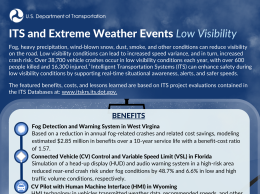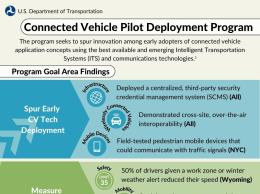Innovations in Freight Port Management
2023 Executive Briefing
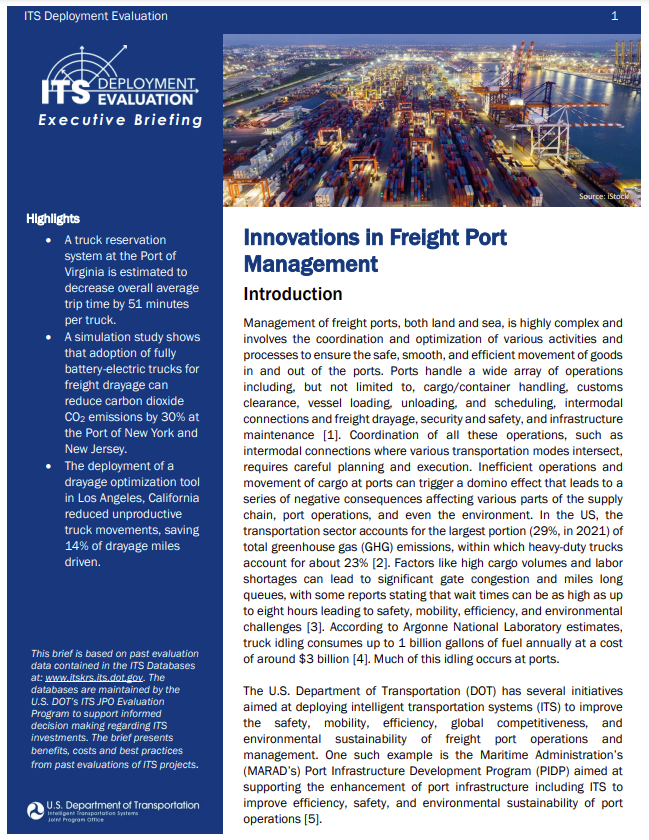 BRIEFING HIGHLIGHTS
BRIEFING HIGHLIGHTS
- A truck reservation system at the Port of Virginia is estimated to decrease overall average trip time by 51 minutes per truck.
- A simulation study shows that adoption of fully battery-electric trucks for freight drayage can reduce carbon dioxide CO2 emissions by 30% at the Port of New York and New Jersey.
- The deployment of a drayage optimization tool in Los Angeles, California reduced unproductive truck movements, saving 14% of drayage miles driven.
Introduction
Management of freight ports, both land and sea, is highly complex and involves the coordination and optimization of various activities and processes to ensure the safe, smooth, and efficient movement of goods in and out of the ports. Ports handle a wide array of operations including, but not limited to, cargo/container handling, customs clearance, vessel loading, unloading, and scheduling, intermodal connections and freight drayage, security and safety, and infrastructure maintenance [1]. Coordination of all these operations, such as intermodal connections where various transportation modes intersect, requires careful planning and execution. Inefficient operations and movement of cargo at ports can trigger a domino effect that leads to a series of negative consequences affecting various parts of the supply chain, port operations, and even the environment. In the US, the transportation sector accounts for the largest portion (29%, in 2021) of total greenhouse gas (GHG) emissions, within which heavy-duty trucks account for about 23% [2]. Factors like high cargo volumes and labor shortages can lead to significant gate congestion and miles long queues, with some reports stating that wait times can be as high as up to eight hours leading to safety, mobility, efficiency, and environmental challenges [3]. According to Argonne National Laboratory estimates, truck idling consumes up to 1 billion gallons of fuel annually at a cost of around $3 billion [4]. Much of this idling occurs at ports.
The U.S. Department of Transportation (DOT) has several initiatives aimed at deploying intelligent transportation systems (ITS) to improve the safety, mobility, efficiency, global competitiveness, and environmental sustainability of freight port operations and management. One such example is the Maritime Administration’s (MARAD’s) Port Infrastructure Development Program (PIDP) aimed at supporting the enhancement of port infrastructure including ITS to improve efficiency, safety, and environmental sustainability of port operations [5].

PIDP is a discretionary grant program administered by MARAD and has funded over $1.4 billion in port infrastructure projects since 2019 [5]. The Bipartisan Infrastructure Law (BIL) invests more than $17 billion in port infrastructure and waterways with the primary goal of addressing needed repairs and maintenance backlogs, reducing congestion to strengthen our supply chains, and removing bottlenecks to expedite commerce [6]. It also aims to cut emissions near ports by boosting electrification and investing in other low-carbon technologies to reduce environmental impacts on neighboring communities.
The U.S. DOT has funded several ITS applications and pilot deployments in freight and commercial vehicle operation domains such as Truck Platooning, Truck Parking Management Systems, Route Guidance Systems, Freight Signal Priority, and Freight Advanced Traveler Information System. However, this executive briefing focuses specifically on freight port operations and management. Read on to learn about how ITS can contribute to improve mobility, safety, and air quality in and around the ports of entry with demonstrated or modeled benefits, costs, best practices, and a success story.
Benefits
Freight Intelligent Transportation Systems

California’s Port of Oakland seaport technology program, titled Global Opportunities at The Port of Oakland (GoPort), involves use of advanced technology to improve operations of arterial roadways in the port environment. GoPort is a suite of 15 freight technology demonstration projects intended to improve safety, efficiency, and reliability of trucks and rail access to the Oakland Port Complex by providing real-time traveler information to truck drivers. Some of the freight port-specific ITS projects being implemented include a port-specific traffic management center (TMC)/emergency operations center (EOC), Wi-Fi for truckers to access traffic and terminal gate updates, changeable message signs to show traffic delays for truckers, vehicle queue detection for accurate measurement of truck turn times, as well as a mobile app for truckers. Improvements in traffic and incident management within the port, its terminals, and access routes improve the safety, efficiency, and reliability of truck and rail access to the port. Furthermore, reduction in congestion and truck idling provides benefits in terms of emissions and improved air quality (2019-B01387). The construction for the project was expected to be completed in the summer of 2023 and preliminary models forecasted a benefit-to-cost (B/C) ratio of 6.2:1 [7]. Additionally, The Port of Virginia’s Truck Reservation System uses radio frequency identification (RFID) technology and real-time information from a cloud-based system to reduce truck idling time at various stages of a typical drayage trip. The reservation system allows truck drivers to conduct most administrative tasks online prior to arriving at the terminal while RFID readers installed at the entry/exit gates allow for automated gate operation for the trucks equipped with RFID tags, saving significant time. This includes time spent at the inbound portal, in queues at the terminal gate, at the gate arm waiting to be dispatched, being processed inside the terminal, at the outbound portal, and in queues at the exit gate. This reduced idling time leads to an average travel time savings of 50.7 minutes per truck and a 61 percent reduction in total air emissions. Overall, the system is expected to reduce truck trip time by 66 percent, saving trucking companies $2.72 Million (2023-B01795).
Freight Drayage Electrification
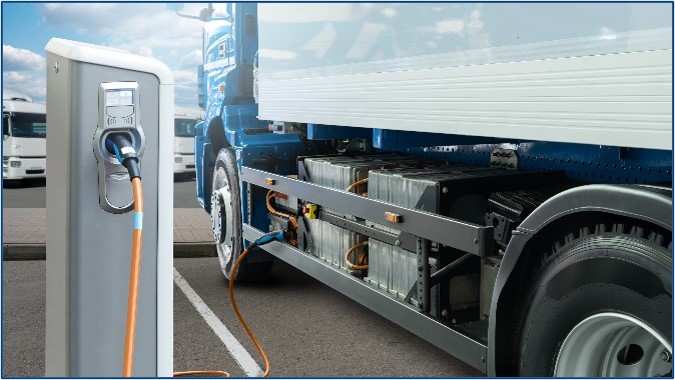
A simulation study by National Renewable Energy Laboratory (NREL) estimates that the full adoption of battery-electric trucks (BETs) for freight drayage can reduce carbon dioxide (CO2) emissions by 75 percent, eliminating 76 Metric Tons of CO2 annually in comparison to diesel trucks at the Port of New York and New Jersey (2023-B01789). Vehicle and engine data from 46 drayage trucks totaling nearly 121,000 miles of operation was collected to develop a simulation model to evaluate the impact of electrification. The studied drayage trucks spent around 9 percent of their energy idling. The study also investigated partial fleet electrification scenarios with current technology and showed that minimal changes to operation would be required for partial fleet electrification scenarios. Another simulation-based drayage operation study in South California showed that an Eco-Approach and Departure (EAD)1 Connected Vehicle application can provide up to 8 percent energy savings for battery electric trucks in light traffic, noting that the EAD application became less effective as the traffic congestion increased (2023- B01796). Another study in Los Angeles (LA), California estimated that by 2035, a 50 percent penetration of electric drayage trucks for near-dock and off-dock service in LA area would reduce GHG emissions by 30 percent (2016-B01118).
Freight Drayage Automation and Optimization

A South Korean study estimated the productivity and environmental benefits of Automated Guided Vehicles (AGVs) at Roll-On/Roll-Off (RORO2) cargo terminals. Ports with RORO terminals still heavily rely on human resources for loading/unloading processes, and use of AGVs at the cargo terminals would reduce operating costs and improve productivity. The study estimated that deploying an AGV RORO Freight Terminal System would reduce the loading times up to 52 percent (2022- B01698). The deployment of a drayage optimization tool in LA for short-haul freight movement reduced unproductive truck movements, saving 14 percent of drayage miles driven (2018-B01299). The data collected was used to assess the performance of drayage operations with and without the optimization planning tool and demonstrated the potential for the system to substantially reduce drayage mileage and improve operational efficiencies.
Costs
The Port of Oakland’s seaport technology program (GoPort) was estimated to have a total cost (including professional services - $2.5 million, final design - $4.1 million, and construction - $24 million) of $30.3 million (2019-SC00429).
| Freight ITS | Project Support | Construction | Annual O&M3 |
|---|---|---|---|
| Radio-Frequency Identification (RFID) | $178,400 | $1,551,600 | $47,390 |
| Changeable Message Signs (CMS) | $216,700 | $1,884,400 | $51,140 |
| Basic GoPort Freight ITS System/App | $120,900 | $1,051,000 | $146,000 |
| Supplemental Vehicle Detection | $86,300 | $750,000 | $26,740 |
| Basic Parking Management | $103,500 | $900,000 | $20,000 |
| Communications (Wi-Fi) | $146,700 | $1,275,500 | $91,840 |
| Communications (Fiber) | $276,800 | $2,406,700 | $13,020 |
| CCTV upgrade to High Definition (HD) | $363,100 | $3,157,700 | $149,580 |
| Joint Traffic Management Center/ Emergency Operations Center (TMC/EOC) | $100,200 | $871,500 | $325,000 |
| Queue detection | $57,500 | $500,000 | $25,300 |
| Center to Center (C2C) Communications | $57,500 | $500,000 | $18,680 |
| Weigh-in-Motion (WIM) Technology | $143,800 | $1,250,000 | $21,710 |
| Initial Advanced Traffic Management System (ATMS) | $241,500 | $2,100,000 | $20,000 |
| Advanced Train Detection System | $34,500 | $300,000 | $27,000 |
| Adaptive Signal System | $120,800 | $1,050,000 | $31,160 |
Another study on zero-emission drayage trucks at the Port of Oakland estimated that the cost for building ten electric charging stations for tenant shippers would be around $1.25 million to $2 million (2023- SC00545). The total projected cost to operate an AGV loading system associated with the previously mentioned South Korean AGV study was estimated to be around $20.1 million, inclusive of a unit capital cost of an AGV around $177,347 based on expert speculation (2022-SC00520).
Best Practices
Freight management has undergone significant advancements through the adoption of ITS technologies, such as use of AGVs, ATMS, advanced traveler information systems (ATIS), drayage electrification and charging station facilities at the port, and use of truck reservation systems. Below are some key lessons learned and best practices from these innovations:

- Freight ITS: Freight ATIS provides real-time data and optimization tools for freight carriers, enabling efficient route planning, cargo tracking, provision of safety alerts, and intermodal integration to enhance the effectiveness of freight transportation. Use the freight ATIS (or FRATIS) system to enable automated communications between multiple stakeholders and improve logistics in the event of traffic delays or changes to wait times at the drayage facilities. Integrating FRATIS with existing drayage operator order management systems was found to decrease operator workloads and errors. Securing clear buy-in from influential stakeholders early on maximized the benefits of FRATIS deployment. Future FRATIS iterations should prioritize flexibility through software approaches, integration methods, and architecture that remains hardware independent, adaptable to varied dispatcher operations, and able to interface with diverse communication platforms (2016-L00736).
- Freight Drayage Electrification and Optimization: A study on zero-emissions drayage truck feasibility suggests that unless charging times reduce significantly or battery technology advances, electric charging stations for zero-emissions drayage trucks are not an affordable option due to demand for significant land use and resemblance to an expansive parking lot (2023-L01200). Electric trucks have demonstrated the potential to reduce emissions and operational costs in drayage operations, particularly for short haul trips. Integrating electric trucks into fleets require careful consideration of charging infrastructure, range limitations, and investments in maintenance training. Partial fleet electrification and optimizing the use of charging infrastructure and facilities can provide immediate benefits with minimal changes to operations (2023-B01789).
- Freight Drayage Automation: According to a report by International Transport Forum (ITF), port automation is not a magic bullet for more efficient operations as there are many complexities involved (2023- L01196). Terminal automation can be a cost-effective measure for specific circumstances such as large terminals with regular container flows and where there are labor shortages. Automation should focus on specific processes within the port’s operation such as use of AGVs for container transport between quayside and the container yard or integration of freight ATIS/ATMS. The introduction of automation can often result in societal conflicts over jobs replaced due to automation of manual tasks. The report also suggests that evaluations of port automation projects need to be made public for wider access to information which will help policy makers to identify under which conditions automation can be most effective.
Success Story
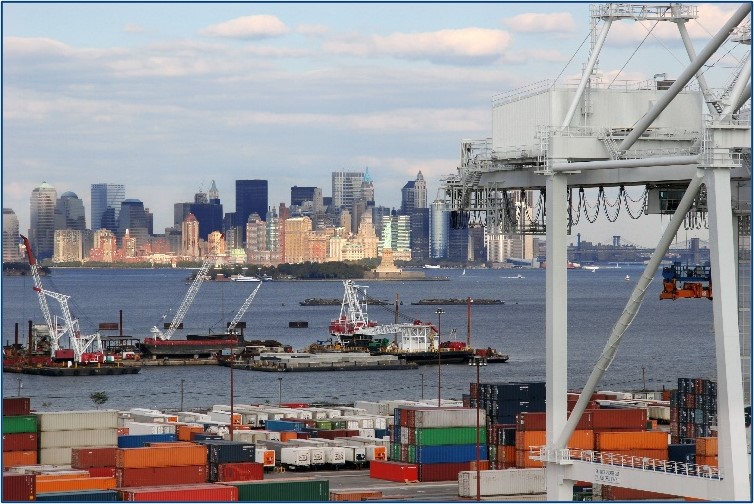
Long drayage truck queues at the terminal gates can contribute significantly to emissions, noise, and traffic congestion in and around ports. Gate management strategies reduce idle emissions at ports by redistributing the truck arrivals away from peak hours and lowering average wait times. In 2017, Global Container Terminals (GCT) introduced a truck appointment system in various phases at Bayonne Terminal located at the Port of New York and New Jersey, becoming the first port in the east coast to implement such a system [9]. The system allows truck drivers to reserve a specific timeslot in advance, distributing the gate arrivals across all hours of operation. The truck appointment system was estimated to have improved the drayage truck turnaround times during appointment hours by more than 40 percent, significantly improving the efficiency of the gate terminal [9, 10]. Other benefits include the reduction of CO2 by 23,149 US tons per year as well as air pollutant reductions of 67 US tons per year, resulting in fuel savings of $5.3 million per year.
1 Eco-Approach and Departure (EAD) is a connected vehicle technology that involves a traffic signal broadcasting its current signal phase and timing (SPaT) data so that approaching trucks can calculate the most energy efficient speed profiles for the truck to follow until it clears the intersection.
2 Roll-On/Roll-Off ships are cargo ships designed to carry wheeled cargo, such as cars, motorcycles, trucks, semi-trailer trucks, buses, trailers, and railroad cars [8]
3 Operations and Maintenance Costs
References
- US EPA, “Ports Primer for Communities,” Jan. 18, 2017. https://www.epa.gov/community-port-collaboration/ports-primer-communities (accessed Aug. 21, 2023).
- US EPA, “Fast Facts on Transportation Greenhouse Gas Emissions,” Aug. 25, 2015. https://www.epa.gov/greenvehicles/fast-facts-transportation-greenhouse-gas-emissions (accessed Aug. 22, 2023).
- G. Kay, “Truckers at backlogged ports say they’ve waited in miles-long lines for up to 8 hours without pay,” Business Insider. https://www.businessinsider.com/truckers-wait-outside-backlogged-ports-8-hours-without-pay-2021-11 (accessed Aug. 22, 2023).
- “Long-Haul Truck Idling Burns Up Profits”, [Online]. Available: https://afdc.energy.gov/files/u/publication/hdv_idling_2015.pdf
- “Port Infrastructure Development Program | MARAD.” https://www.maritime.dot.gov/PIDPgrants (accessed Aug. 22, 2023).
- “Bipartisan Infrastructure Law: Maritime Administration | MARAD.” https://www.maritime.dot.gov/about-us/bipartisan-infrastructure-law-maritime-administration (accessed Aug. 22, 2023).
- Alameda County Transportation Commission, “GoPort Freight Intelligent Transportation System Project.” Jul. 2023. [Online]. Available: https://www.alamedactc.org/wp-content/uploads/2023/07/1442000_7SGSP_FITS_FS_20230711.pdf
- “Roll-on/roll-off,” Wikipedia. Jul. 04, 2023. Accessed: Aug. 25, 2023. [Online]. Available: https://en.wikipedia.org/w/index.php?title=Roll-on/roll-off&oldid=1163439353
- US EPA, “Port Gate Management Strategies Improve Air Quality and Efficiency at Ports,” Aug. 07, 2020. https://www.epa.gov/ports-initiative/port-gate-management-strategies-improve-air-quality-and-efficiency-ports (accessed Aug. 27, 2023).
- US EPA, “GCT Bayonne’s Drayage Truck Appointment System,” Apr. 19, 2018. https://www.epa.gov/ports-initiative/gct-bayonnes-drayage-truck-appointment-system (accessed Aug. 08, 2023).
